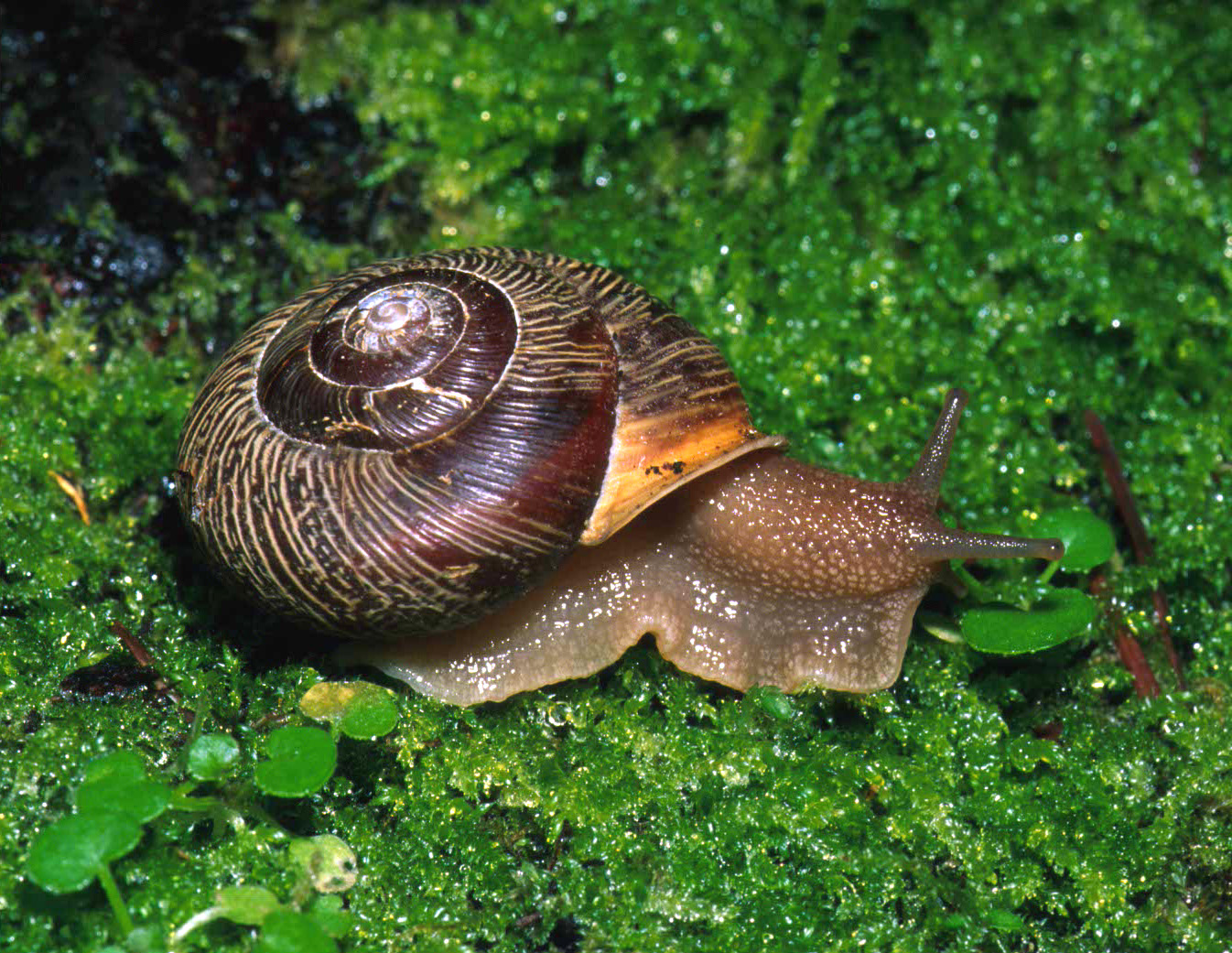
Allogona townsendiana (I. Lea 1838) Oregon Forestsnail
Polygyridae, Pulmonata ,Gastropoda, Mollusca, Animalia
Range: In Washington it is known from Puget Sound lowlands and foothills of Olympic, Cascade and Coast ranges: Whatcom, Skagit, Snohomish, King, Pierce, Thurston, Lewis, Cowlitz, Skamania, Clark, Whakiakum, Pacific, Grays Harbor, Jefferson, Mason, Kitsap, Clallam?, Island?, San Jaun?, Klickitat? and Yakima? counties. In Oregon the range extends along the Columbia River from its mouth to about The Dalles and south into the northern Coast Range and western Cascade foothills down the Willamette River Valley to around the upper Umpqua River drainage: Clatsop, Columbia, Multnomah, Hood River, Wasco, Sherman?, Gilliam? Oregon City, Washington, Tillamook?, Yamhill?, Polk?, Marion?, Linn, Lane, ...???. In Canada, the British Colombia records are largely from the Fraser Valley, where it ranges onto the northern shore, and in the Mission/ Abbotsford/ Chilliwack area and from the lower Chilliwack Valley with additional localities in Langley and south Vancouver Island.
Identification: A. townsendiana could be confused with a variety of snails in the area. Monadenia fidelis is another common and large snail, but is more colorful and usually has a yellowish lateral band seperating light brown above with a darker brown below. The next four species are all Polygyrid snails and all have a similar reflected lip as adults. Allogona ptychophora is smaller and occurs on the east side of the Cascades. Cryptomastix devia is found simpatrically and often shows white shell exposed by the worn brown periostracum, but has an apertural tooth. Cryptomastix germana and Vespericola columbiana are much smaller and both have hairs protruding from the periostracum
Description: The shell diameter is 1.4 to 1.7 times height, with 5 to 6 whorls that contain lighter colored axial ribs, and ranges from 28 to 35mm. The umbilicus is about 12% of the diameter and partly covered by the thickened white reflected lip of the aperature. The periostracum (outer covering on shell) is reddish-brown and usually at least partially eroded revealing white shell substance beneath. The last whorl descends in full-grown shells. The body is cream colored. Descriptions are provided by Pilsbry (1940) and Kozloff (1976).
Natural History:
The current classification of the species is as follows: Phylum Mollusca: Class Gastropoda: Subclass Pulmonata: Order Stylommatophora: Suborder Sigmurethra; Superfamily Polygyroidea: Family Polygyridae: Subfamily Polygyrinae: Tribe Allogonini: Genus Allogona: Subgenus Dysmedoma: Species Allogona townsendiana.
Tolmiea menziesii, Urtica dioica
Conservation Status: In Canada this species was listed as endangered in 2002....
Literature Cited:
COSEWIC. 2002. COSEWIC assessment and status report on the Oregon forestsnail, Allogona townsendiana, in Canada. Committee on the Status of Endangered Wildlife in Canada. Ottawa. vi + 20 pp. URL: http://www.sararegistry.gc.ca/status/showDocument_e.cfm?id=118. [Status report prepared by R.G. Forsyth and K.E. Ovaska.]
Emberton, K.C. 1994. Polygyrid land snail phylogeny: external sperm exchange, early North American biogeography, iterative shell evolution. Biological Journal of the Linnean Society 52:241–271.
Emberton, K.C. 1995. When shells do not tell: 145 million years of evolution in North America’s polygyrid land snails, with a vision and conservation priorities. Malacologia 37:69–110.
Frest, T.J., & E.J. Johannes. 1995. Interior Columbia Basin mollusk species of special concern. Final Report, contract #43-0E00-4-9112, Interior Columbia Basin Ecosystem Management Project, Walla Walla, Washington. xi + 274 pp.
Kozloff, E.N. 1976. Plants and animals of the Pacific Northwest: An illustrated guide to the natural history of western Oregon, Washington, and British Columbia. J.J. Douglas, Vancouver. viii + 264 pp.
Pilsbry, H.A. 1940. Land Mollusca of North America (north of Mexico). The Academy of Natural Sciences of Philadelphia, Monograph 3, 1(2):575–994, i–ix.
Turgeon, D.D., J.F. Quinn, A.E. Bogan, E.V. Coan, F.G. Hochberg, W.G. Lyons, P.M. Mikkelsen, R.J. Neves, C.F.E. Roper, G. Rosenberg, B. Roth, A. Scheltema, F.G. Thompson, M. Vecchione, & J.D. Williams. 1998. Common and scientific names of aquatic invertebrates from the United States and Canada: Mollusks. Second edition. American Fisheries Society Special Publication 26: ix + 526.
Synonyms and Classification:
= Helix townsendiana
= A. townsendiana brunnea
= A. townsendiana frustrationis
No subspecies are currently recognized. A. townsendiana brunnea (Vanatta 1924) from near Kelso, Cowlitz County, Washington, and A. townsendiana frustrationis (Pilsbry 1940) named from Cape Disappointment, Pacific County, Washington, are both synonyms as regarded by Branson (1977) and Forsyth (in preperation) repectively. The other synonyms listed are from Pilsbry (1940).
The current classification of the species is as follows: Phylum Mollusca: Class Gastropoda: Subclass Pulmonata: Order Stylommatophora: Suborder Sigmurethra; Superfamily Polygyroidea: Family Polygyridae: Subfamily Polygyrinae: Tribe Allogonini: Genus Allogona: Subgenus Dysmedoma: Species Allogona townsendiana.
The genus Allogona is currently believed to contain four species: A. lombardii (A. G. Smith, 1943), A. profunda ([Say, 1821]), A. ptychophora ([A.D. Brown, 1870]), and A. townsendiana (Pilsbry 1940; Turgeon et al. 1998). The three western species, A. lombardii, A. ptychophora and A. townsendiana, belong to the anatomically distinct subgenus Dysmedoma. Additionally, Pilsbry (1940) lists several nominal subspecies, and at least one of these, A. ptychophora solida (Vanatta, 1924), is speculated to be a full species (Frest & Johannes 995).
Etymology: allos – different, gona – genitalia; named for John K. Townsend, naturalist